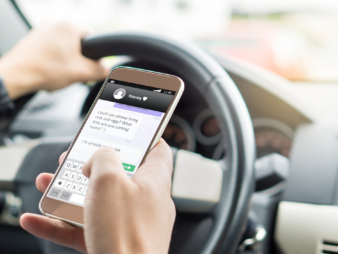Texting while driving isn’t just dangerous, it’s illegal in Ohio. And if you’re injured in a crash caused by a distracted driver, those laws can play a critical role in your personal injury claim. Here’s what you need to know about Ohio’s texting and driving laws and how they impact your right to compensation.
Ohio’s Texting and Driving Laws: What’s Prohibited
Under Ohio Revised Code §4511.204, it is illegal to operate a motor vehicle on any street, highway, or property open to the public for vehicular traffic while using, holding, or physically supporting with any part of the person’s body an electronic wireless communications device. While there are exceptions to this prohibition, they are limited and generally geared toward emergency situations and use of a device hands-free.
Pursuant to Ohio Revised Code §4511.205, for drivers under 18, all wireless device use is banned, including hands-free options.
Enforcement and Penalties
Texting and driving is now a primary offense in Ohio. That means law enforcement can pull you over solely for using your phone illegally—no other violations are required.
Penalties include:
- First offense: Up to $150 fine and 2 points on your license
- Second offense within two years of first offense: Up to $250 fine and 3 points
- Third or subsequent offense within two years of first offense: Up to $500 fine, 4 points, and possible 90-day license suspension
Fines double in construction zones.
How It Affects Your Injury Claim
If you’re injured in a crash caused by a texting driver, Ohio law is on your side.
- Negligence Per Se: Texting while driving is considered negligence per se in Ohio. That means violating the law is automatically regarded as negligent behavior in a civil case. You don’t have to prove the driver was careless—just that they broke the law.
- Evidence of Distraction: Proving the other driver was distracted strengthens your claim. Evidence may include police reports, witness statements, phone records, and accident reconstruction. Law enforcement may request phone records in serious crashes to confirm distraction.
Hands-Free Isn’t Risk-Free
While hands-free use is legal, it still poses cognitive distractions. If a driver was legally using a device but not paying attention, they may still be held liable for negligence. Insurance companies and courts consider all forms of distraction when determining fault.
What to Do After a Distracted Driving Accident
If you suspect the other driver was texting or distracted:
- Call the police and file a report of the incident.
- Document the scene with photos and witness information.
- If injured, seek medical attention immediately.
- Avoid discussing fault at the scene.
- Contact a personal injury attorney to protect your rights.
Final Thoughts
Ohio’s texting and driving laws are designed to reduce accidents and hold distracted drivers accountable. If you’re injured because someone chose to text behind the wheel, these laws can help you build a strong case for compensation. Don’t navigate the legal process alone—an experienced attorney can help you gather evidence, negotiate with insurers, and fight for the justice you deserve.
Tagged In:LitigationPersonal Injury and Wrongful DeathTexting and Driving




